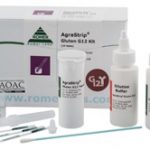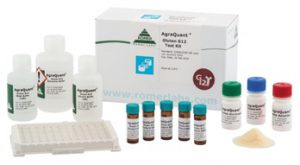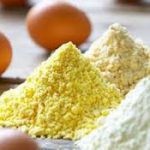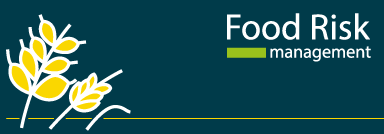
Allergenen testoplossingen:
| Detectiemethoden: Testkits | |
| Referentie materiaal allergenen |
Voedings allergenen testmethoden
Allergenen zijn gezamenlijk met pathogenen de grootste oorzaak van product terugroepacties (recalls), met als belangrijkste risicofactor een potentiële kruisbesmetting met allergenen tijdens productieprocessen. Voedingsmiddelen producenten zullen dan ook trachten het risico op kruiscontaminatie te minimaliseren. Een belangrijk onderdeel van het allergeenbeheer is het testen op de aan- of afwezigheid van allergeen eiwitten in de omgeving en eindproducten.
Romer Labs allergeen detectie methoden 2020
Food Risk Management biedt op voedingsallergenen analyse gebied een breed pakket aan detectiemethoden. Ons assortiment van Romer Labs omvat eenvoudige snel testkits onder de AgraStrips<-> range voor de eenvoudige kwalitatieve on-site analyse van allergenen. Daarnaast verkopen wij kwantitatieve enzymatische immuno-assay testkits onder de AgraQuant<-> range specifiek voor food laboratorium.
In samenwerking met LGC UK<-> heeft RomerLabs voor 2020 een 5 tal referentie materialen voor voedingsallergenen op de markt gebracht.
• FAQ testmethode assortiment allergeen testkits RomerLabs 2020 <PDF>


Food Risk Management is de juiste partner om uw kwaliteitsafdeling te ondersteunen bij allergeenbeheer.
Neem vrijblijvend contact op met FRM om bijv. onze Romer Labs testoplossingen voor allergeen analyse in een voedingsmiddelen productie omgeving met u in detail te bespreken. Email: support@foodriskmanagement.nl
Bij de FRM ondersteuning van uw allergenen management kunt u denken aan:
- Inzicht in allergenen en hoe deze te detecteren binnen het productieproces van voedingsmiddelen.
- Welke verschillende detectiemethoden bestaan er voor allergenen analyse en hoe onderscheiden dergelijke test systemen zich onderling.
- Wat kan er exact worden gemeten met allergeen analyse ‘tools’.
- Valkuilen bij allergenen analyse en de begrenzingen van de huidige test systemen.
- Complexe matrixen en het uitvoeren van betrouwbare analyses op allergenen.
- Gevoeligheid en specificiteit zijn belangrijk bij allergeen test systemen. Voor de toepasbaarheid van een test is het vaststellen van een drempelwaarde essentieel
Allergenen in detail
 Veertien verschillende stoffen zijn opgenomen in de lijst van belangrijkste voedingsallergenen, die intoleranties of allergieën kunnen veroorzaken: verord. 1169/2011
Veertien verschillende stoffen zijn opgenomen in de lijst van belangrijkste voedingsallergenen, die intoleranties of allergieën kunnen veroorzaken: verord. 1169/2011
- Gluten bevattende granen, namelijk tarwe, rogge, gerst, haver en producten op basis van glutenbevattende granen
- Schaaldieren en producten op basis van schaaldieren.
- Eieren en producten op basis van eieren.
- Vis en producten op basis van vis.
- Aardnoten en producten op basis van aardnoten.
- Soja en producten op basis van soja.
- Melk en producten op basis van melk (inclusief lactose).
- Noten, namelijk amandelen, hazelnoten, walnoten, cashewnoten, pecannoten, paranoten, pistachenoten, macadamianoten, en producten op basis van noten.
- Selderij en producten op basis van selderij.
- Mosterd en producten op basis van mosterd.
- Sesamzaad en producten op basis van sesamzaad.
- Zwaveldioxide en sulfieten in concentraties van meer dan 10 mg/kg of 10 mg/l.
- Lupine en producten op basis van lupine.
- Weekdieren en producten op basis van weekdieren.
Deze allergenen moeten altijd worden vermeld als ze bij de productie of de bereiding van een levensmiddel worden gebruikt en nog in het eindproduct aanwezig zijn, zelfs in een gewijzigde vorm. Ze moeten altijd vermeld worden, ongeacht hun gehalte, behalve sulfiet waarvoor een meldingsdrempel is vastgelegd (10 mg/kg of l).
Gluten
detectie methoden gluten:
Gluten-free – How can you prove it?
Over the past decade the demand for gluten-free food has soared and, therefore, more and more of these products can be found in the stores. The spectrum of consumers with difficulties in digesting gluten has grown to around 10%. These individuals show varying degrees of sensitivity towards gluten, but their situation generally improves when following a gluten-free diet. Furthermore, there is a growing perception amongst increasing numbers of consumers that a gluten-free diet is better for you. But what is gluten? Why can it be toxic? And how can gluten be detected in food?
What is Gluten?
The name “gluten” is derived from the Latin word for glue and it refers to the composite of the proteins called prolamins and glutelins found in wheat, barley rye, oats and their crossbred varieties. Prolamins are defined as the fraction that can be extracted using 40-70% of ethanol and this fraction is called gliadin, hordein, secalin or avenin respectively, depending on the grain variety. In general, it can be estimated that prolamins and glutelins occur in the same ratio in gluten.
Worldwide, gluten is an important source of nutritional protein, both in foods prepared directly from sources containing it, and as an additive to foods otherwise low in protein. Gluten contributes texture and form to food products, due to its physicochemical properties. Together with water and when kneaded, gluten forms a viscoelastic dough with a special protein network which is responsible for the shape of bakery products.
Coeliac Disease
Following the transition from the hunter-gatherer lifestyle to the beginning of agriculture 10,000 years ago, cereals have been a main pillar of the human diet, which raises the question as to why gluten is causing increasing levels of health problems nowadays. Approximately 1% of the world’s population is affected by coeliac disease – an immune-mediated enteropathy caused by the ingestion of gluten
New law on gluten-free: The Codex standard Codex Alimentarius Standard for Gluten-Free Foods
The European Commission has decided to use the Codex standard as the basis for a law on the labelling of food for people who are gluten intolerant. The law came into full effect in January 2012.
There is a level of gluten which is considered to be safe to eat for people with coeliac disease. This level, which is the amount of gluten allowed in gluten-free products, is known as the Codex standard.
The Codex standard now has two categories: Foods containing 20ppm or less gluten
Only foods that contain 20ppm or less can be labelled as ‘gluten-free’.
The term ‘gluten-free’ implies no gluten, but in practice a zero level does not exist. It is impossible to eat a zero gluten diet, because even naturally gluten-free cereals such as rice can contain up to 20ppm or 20mg/kg of gluten. Research shows that this tiny amount of gluten is not toxic to people with coeliac disease who can eat unlimited amounts of products with gluten at a level of 20ppm or less.
Gluten Analysis
As there are regulations in place, there is a need for appropriate detection methods for gluten in food. Several technologies such as specific antibody based tests e.g. enzyme linked immunosorbent assays (ELISA) or lateral flow assays, polymerase chain reaction (PCR) methods and newer concepts like mass spectrometry are available – all with varying degrees of commercialisation – giving both qualitative and quantitative results.
The G12 antibody employed in the AgraQuant® Gluten G12 ELISA and AgraStrip® Gluten G12 Lateral Flow Test belongs to this next generation.
The Next Generation of Gluten Analysis
The G12 antibody specifically recognizes the 33-mer of the gliadin protein present in gluten. This toxic fragment was identified by the University of Stanford and published in 2002 in a paper in Science. The G12 antibody was raised against this 33-mer peptide using knowledge gained from this publication, and recognizes the hexapeptide sequence QPQLPY and similar peptides found in barley, rye and oats. In contrast, the R5 antibody was raised against a secalin extract and later the epitope it reacts with was identified as the QQPFP pentapeptide. The distinction between the two antibodies relates to the fact that the G12 antibody specifically targets the toxic fragment that triggers the auto-immune reaction in coeliac patients, rather than a peptide sequence unrelated to clinical outcomes. It was confirmed during validation studies that G12 does not give any false positive signals with soy and is, therefore, suitable for measuring gluten in products containing soy. There is also no cross reactivity to maize or rice.
